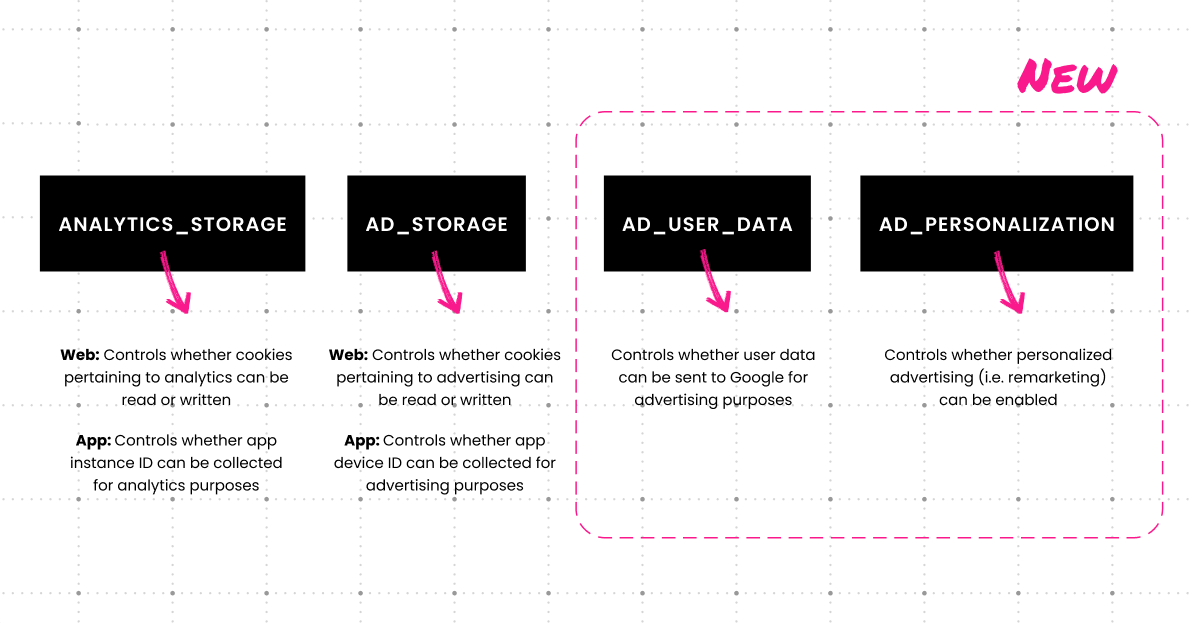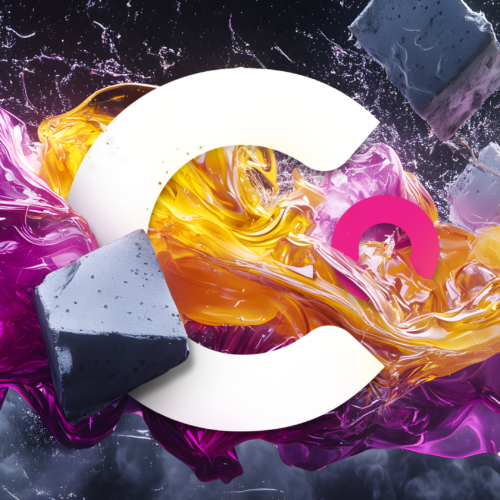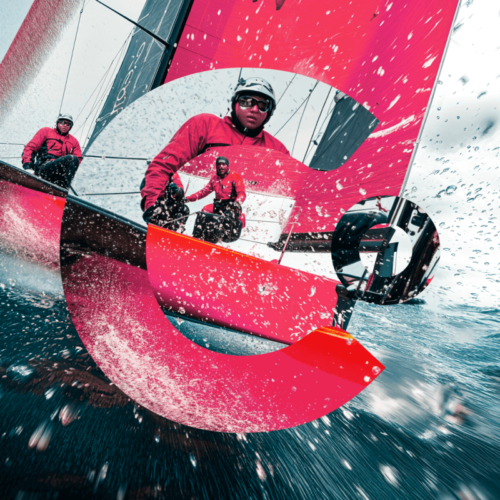At Clear Digital, we recognize the transformative power of Google Consent Mode V2 in reshaping the digital landscape to align with the evolving demands of user consent and data privacy. As businesses grapple with the challenges posed by stringent privacy regulations like the GDPR and CCPA, the need to balance compliance with the utilization of critical data for analytics and advertising has never been more pressing. Google Consent Mode V2 emerges as a pivotal solution, enabling websites to fine-tune their data collection, usage, and storage practices according to users’ consent preferences.
This approach not only facilitates the ethical handling of data, ensuring that businesses can continue to extract valuable insights and refine their digital marketing strategies without compromising user privacy, but also seamlessly integrates with essential tools like Google Tag Manager. The adaptability and dynamic nature of Consent Mode V2 underscore its critical role in today’s digital domain. It not only ensures adherence to global privacy laws but also heralds a move towards more ethical data practices, aligning business operations with the heightened expectations of consumers and regulators. Clear Digital is dedicated to empowering our clients through the complexities of implementing Google Consent Mode V2, ensuring that your digital strategies are both effective and respectful of privacy considerations.
The Evolution of Digital Consent
The concept of digital consent has undergone significant evolution in recent years, primarily driven by the introduction of comprehensive privacy regulations like the General Data Protection Regulation (GDPR) in the European Union and the California Consumer Privacy Act (CCPA) in the United States. These regulations were enacted in response to growing concerns over personal data misuse, aiming to give individuals greater control over their information. GDPR, effective from May 2018, set a new benchmark for privacy laws worldwide, requiring businesses to obtain explicit consent from users before collecting, processing, or sharing their data. Similarly, CCPA, which came into effect in January 2020, provided California residents with unprecedented rights regarding their personal information, including the right to know about and opt out of the sale of their data.
In this regulatory context, Google introduced Consent Mode as a tool for businesses to align their website data practices with the new legal standards of consent. Consent Mode allowed websites to continue leveraging Google’s analytics and advertising services by adjusting data collection based on the consent status of users. This was a significant development, as it helped businesses maintain compliance while still capturing valuable insights for optimizing their online presence and advertising strategies.
Consent Mode V2 represents a further evolution of digital consent management practices. Building on the foundation laid by its predecessor, V2 introduces more granular control over consent settings, offering businesses the ability to fine-tune how different types of user data are handled based on specific consent preferences. This enhanced flexibility is crucial for navigating the nuanced requirements of various global privacy regulations. Moreover, Consent Mode V2’s integration capabilities with platforms like Google Tag Manager and third-party consent management tools have made it easier for businesses to implement comprehensive, user-centric consent strategies. This evolution reflects a broader shift towards prioritizing user privacy and consent in the digital ecosystem, marking a significant step forward in ethical data practices and compliance management.

How Google Consent Mode V2 Works
Google Consent Mode V2 operates by adjusting the way websites collect, process, and store user data in alignment with the users’ consent preferences, thereby ensuring compliance with privacy regulations while still enabling businesses to gather crucial analytics and advertising insights. At its core, Consent Mode V2 relies on consent signals to manage user data, which are essentially instructions received from the user’s consent preferences. These signals determine whether and how various Google services, like Google Analytics and Google Ads, can collect and use data.
Basic and Advanced Modes
Consent Mode V2 is designed with flexibility in mind, offering both basic and advanced modes to cater to different levels of implementation complexity and customization needs.
- In Basic Consent Mode: In this mode, Consent Mode operates on a more general level, using default settings for handling consent signals. If a user does not consent to cookies or data collection for analytics and advertising, Consent Mode automatically restricts these activities, ensuring compliance with minimal setup.
- Advanced Consent Mode: This mode allows for a more granular approach to consent management. Businesses can specify exactly how each type of Google service should respond to different consent states, such as ‘granted’ or ‘denied’, for various categories of data use (e.g., advertising, analytics). This enables a highly customized implementation that can dynamically adjust the website’s functionality and data collection practices based on detailed user consent preferences.
Consent Signals and Their Impact
Consent signals play a crucial role in Consent Mode V2, acting as the mechanism through which user preferences are communicated and enforced across Google’s tools. When a user provides or withholds consent, these signals are sent to inform Google services of the consent state, which then adjust their data collection and processing behaviors accordingly. For example, if consent for ‘analytics_storage’ is denied, Google Analytics will limit data collection to only what is necessary for maintaining basic site functionality, without tracking individual user behavior.
This consent-based approach to data management allows businesses to respect user privacy while still accessing aggregated data for insights, thus striking a balance between compliance and data-driven decision-making. The introduction of Consent Mode V2 represents a significant advancement in privacy-centric analytics, enabling more sophisticated and ethical handling of user data in the digital age.

Setting up Google Consent Mode in Google Tag Manager
Setting up Google Consent Mode in Google Tag Manager involves configuring your tags, triggers, and variables to adjust to user consent. This setup allows your website to respect user preferences regarding data collection, impacting how analytics and advertising tags function.
Step-by-Step Setup in Google Tag Manager
- Initialize Consent Mode: First, you need to initialize Consent Mode with Google Tag Manager. This is done by adding a new tag in Google Tag Manager, selecting ‘Consent Initialization’ as the tag type, and configuring it to fire on all pages. This tag sets the default consent state for all subsequent tags that will fire.
- Configure Consent State: Use the updateConsent command within Google Tag Manager to change the consent state based on user actions. For instance, if a user accepts cookies, you would trigger an event to update the consent state to reflect this choice, enabling more comprehensive data collection.
- Adjust Tag Behavior: Create triggers in Google Tag Manager that correspond to the different consent states. For example, you might have one trigger for when analytics consent is granted and another for when it is denied. These triggers will control when certain tags can fire.
Examples of Adjusted Tags
- Analytics Tags: If a user denies consent for analytics cookies, your Google Analytics tags can be adjusted to either not fire at all or to collect only anonymized data, significantly reducing the granularity of insights available.
- Advertising Tags: For advertising efforts, if consent is not granted for ad personalization cookies, Google Ads tags can be adjusted to only show general advertisements rather than personalized ones, impacting the effectiveness and targeting of your campaigns.
By strategically configuring tags and triggers based on consent in Google Tag Manager, businesses can ensure their websites remain compliant with privacy regulations while still leveraging data for analytics and advertising to the extent permitted by user consent.
The Benefit of Consent Management Platforms
Consent Management Platforms (CMPs) play a crucial role in the digital landscape by helping businesses navigate the complexities of collecting user consent in a compliant and user-friendly manner. CMPs streamline the process of obtaining, storing, and managing user consent for cookies and data collection, ensuring websites adhere to stringent privacy regulations like GDPR and CCPA. Working with a CMP is beneficial because it automates the consent gathering process, significantly reducing the risk of non-compliance and enhancing user trust through transparent data practices.
Popular options like OneTrust and Cookiebot offer robust solutions for consent management. OneTrust is known for its comprehensive privacy management software that caters to large enterprises needing detailed consent records and data mapping. Cookiebot, on the other hand, provides a more focused solution for managing cookie consent, making it accessible for businesses of all sizes.
Tools like Cookiebot complement Google Consent Mode by directly managing cookie consent and communicating the user’s preferences to Consent Mode V2. This integration allows for the dynamic adjustment of data collection practices in real-time, based on the consent provided. The synergy between CMPs and Google Consent Mode V2 enhances privacy compliance, as CMPs handle the intricacies of consent collection and documentation, while Consent Mode V2 ensures that Google’s tools respect these consent preferences, offering a seamless approach to ethical data use and privacy protection.
The Impact of Google Consent Mode on Digital Marketing
The implementation of Google Consent Mode V2 is pivotal for modern marketing efforts, especially for those relying on Google Ads. By enabling websites to adjust their data collection practices based on user consent, Google Consent Mode V2 ensures that advertisers can continue to run effective campaigns while complying with privacy regulations. Without adopting this framework, businesses face significant challenges that can detrimentally affect their marketing strategies.
Firstly, a lack of implementation can lead to non-compliance with stringent privacy laws like GDPR and CCPA, resulting in hefty fines and a tarnished brand reputation. More directly related to marketing efforts, failing to utilize Google Consent Mode V2 can severely impact the effectiveness of Google Ads. Without consent-based adjustments, businesses might collect less data on user interactions and conversions, leading to less informed and less optimized advertising strategies. This limitation hinders the ability to target ads effectively, track campaign performance accurately, and ultimately, achieve a lower return on investment.
Furthermore, ignoring Consent Mode V2 can damage trust with users who are increasingly concerned about their online privacy. In today’s digital environment, respecting user consent is not just a legal requirement but a crucial element of customer relationship management. Thus, embracing Google Consent Mode V2 is essential for maintaining competitive edge, compliance, and trust in digital marketing landscapes.
Conclusion
In the intricate dance of digital privacy and data utilization, Google Consent Mode V2 emerges as a pivotal framework, adeptly balancing the scales between compliance with stringent privacy laws like GDPR and CCPA, and the operational needs of analytics and advertising. This evolution in digital consent management, enriched by its nuanced control through basic and advanced modes and harmonious integration with essential tools such as Google Tag Manager and CMPs like OneTrust and Cookiebot, represents a significant leap forward. Clear Digital stands at the forefront of this transition, ready to guide businesses through the complexities of implementing Consent Mode V2. Our expertise not only ensures a seamless adaptation of your digital strategies to respect user privacy but also maintains the integrity and effectiveness of your marketing campaigns, especially in leveraging Google Ads. Without this crucial adaptation, businesses risk both the efficacy of their marketing efforts and compliance with privacy regulations, underscoring the indispensable role of Google Consent Mode V2 in the modern digital landscape. At Clear Digital, we’re committed to navigating these challenges alongside our clients, implementing ethical data practices and robust privacy compliance strategies that safeguard and enhance your digital presence.






